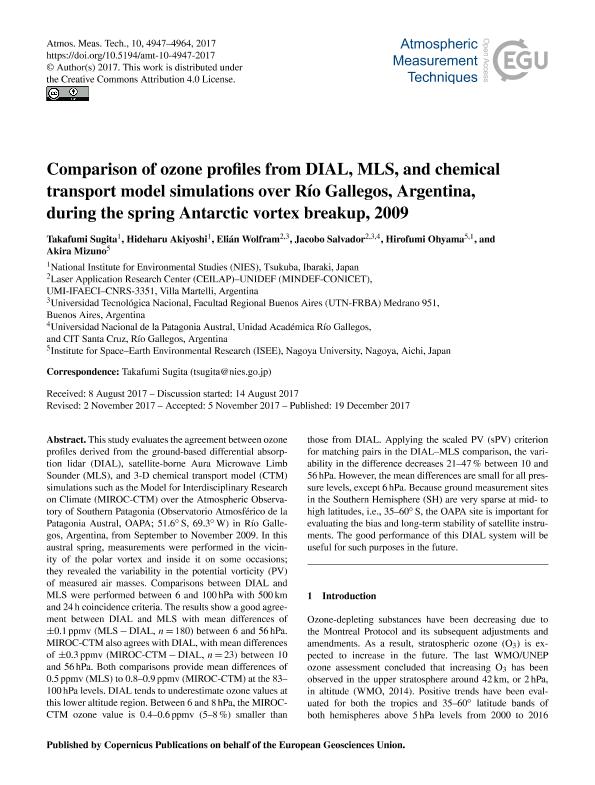Mostrar el registro sencillo del ítem
dc.contributor.author
Sugita, Takafumi
dc.contributor.author
Akiyoshi, Hideharu
dc.contributor.author
Wolfram, Elian Augusto

dc.contributor.author
Salvador, Jacobo Omar

dc.contributor.author
Ohyama, Hirofumi
dc.contributor.author
Mizuno, Akira
dc.date.available
2018-04-09T18:52:06Z
dc.date.issued
2017-12
dc.identifier.citation
Sugita, Takafumi; Akiyoshi, Hideharu; Wolfram, Elian Augusto; Salvador, Jacobo Omar; Ohyama, Hirofumi; et al.; Comparison of ozone profiles from DIAL, MLS, and chemical transport model simulations over Río Gallegos, Argentina, during the spring Antarctic vortex breakup, 2009; Copernicus GmbH; Atmospheric Measurement Techniques; 10; 12; 12-2017; 4947-4964
dc.identifier.issn
1867-8548
dc.identifier.uri
http://hdl.handle.net/11336/41376
dc.description.abstract
This study evaluates the agreement between ozone profiles derived from the ground-based differential absorption lidar (DIAL), satellite-borne Aura Microwave Limb Sounder (MLS), and 3-D chemical transport model (CTM) simulations such as the Model for Interdisciplinary Research on Climate (MIROC-CTM) over the Atmospheric Observatory of Southern Patagonia (Observatorio Atmosférico de la Patagonia Austral, OAPA; 51.6°S, 69.3°W) in Río Gallegos, Argentina, from September to November 2009. In this austral spring, measurements were performed in the vicinity of the polar vortex and inside it on some occasions; they revealed the variability in the potential vorticity (PV) of measured air masses. Comparisons between DIAL and MLS were performed between 6 and 100hPa with 500km and 24h coincidence criteria. The results show a good agreement between DIAL and MLS with mean differences of ±0.1ppmv (MLS-´DIAL, n,=-) between 6 and 56hPa. MIROC-CTM also agrees with DIAL, with mean differences of ±0.3ppmv (MIROC-CTM-´DIAL, n,=-23) between 10 and 56hPa. Both comparisons provide mean differences of 0.5ppmv (MLS) to 0.8-0.9ppmv (MIROC-CTM) at the 83-100hPa levels. DIAL tends to underestimate ozone values at this lower altitude region. Between 6 and 8hPa, the MIROC-CTM ozone value is 0.4-0.6ppmv (5-8%) smaller than those from DIAL. Applying the scaled PV (sPV) criterion for matching pairs in the DIAL-MLS comparison, the variability in the difference decreases 21-47% between 10 and 56hPa. However, the mean differences are small for all pressure levels, except 6hPa. Because ground measurement sites in the Southern Hemisphere (SH) are very sparse at mid-to high latitudes, i.e., 35-60°S, the OAPA site is important for evaluating the bias and long-Term stability of satellite instruments. The good performance of this DIAL system will be useful for such purposes in the future.
dc.format
application/pdf
dc.language.iso
eng
dc.publisher
Copernicus GmbH
dc.rights
info:eu-repo/semantics/openAccess
dc.rights.uri
https://creativecommons.org/licenses/by-nc-sa/2.5/ar/
dc.subject
Dial
dc.subject
Ozone Profile
dc.subject
Mls
dc.subject.classification
Meteorología y Ciencias Atmosféricas

dc.subject.classification
Ciencias de la Tierra y relacionadas con el Medio Ambiente

dc.subject.classification
CIENCIAS NATURALES Y EXACTAS

dc.title
Comparison of ozone profiles from DIAL, MLS, and chemical transport model simulations over Río Gallegos, Argentina, during the spring Antarctic vortex breakup, 2009
dc.type
info:eu-repo/semantics/article
dc.type
info:ar-repo/semantics/artículo
dc.type
info:eu-repo/semantics/publishedVersion
dc.date.updated
2018-04-09T15:19:42Z
dc.journal.volume
10
dc.journal.number
12
dc.journal.pagination
4947-4964
dc.journal.pais
Alemania

dc.journal.ciudad
Katlenburg-Lindau
dc.description.fil
Fil: Sugita, Takafumi. National Institute for Environmental Studies; Japón
dc.description.fil
Fil: Akiyoshi, Hideharu. National Institute for Environmental Studies; Japón
dc.description.fil
Fil: Wolfram, Elian Augusto. Consejo Nacional de Investigaciones Científicas y Técnicas. Unidad de Investigación y Desarrollo Estratégico para la Defensa. Ministerio de Defensa. Unidad de Investigación y Desarrollo Estratégico para la Defensa; Argentina. Ministerio de Defensa; Argentina. Consejo Nacional de Investigaciones Científicas y Técnicas. Instituto de Investigaciones Científicas y Técnicas para la Defensa. Centro de Investigación en Láseres y Aplicaciones; Argentina. Universidad Tecnológica Nacional. Facultad Regional Buenos Aires; Argentina
dc.description.fil
Fil: Salvador, Jacobo Omar. Consejo Nacional de Investigaciones Científicas y Técnicas. Unidad de Investigación y Desarrollo Estratégico para la Defensa. Ministerio de Defensa. Unidad de Investigación y Desarrollo Estratégico para la Defensa; Argentina. Ministerio de Defensa; Argentina. Consejo Nacional de Investigaciones Científicas y Técnicas. Instituto de Investigaciones Científicas y Técnicas para la Defensa. Centro de Investigación en Láseres y Aplicaciones; Argentina. Universidad Tecnológica Nacional. Facultad Regional Buenos Aires; Argentina. Universidad Nacional de la Patagonia Austral; Argentina
dc.description.fil
Fil: Ohyama, Hirofumi. National Institute for Environmental Studies; Japón. Nagoya University; Japón
dc.description.fil
Fil: Mizuno, Akira. Nagoya University; Japón
dc.journal.title
Atmospheric Measurement Techniques
dc.relation.alternativeid
info:eu-repo/semantics/altIdentifier/doi/http://dx.doi.org/10.5194/amt-10-4947-2017
dc.relation.alternativeid
info:eu-repo/semantics/altIdentifier/url/https://www.atmos-meas-tech.net/10/4947/2017/
Archivos asociados
